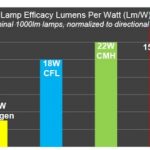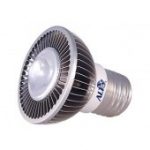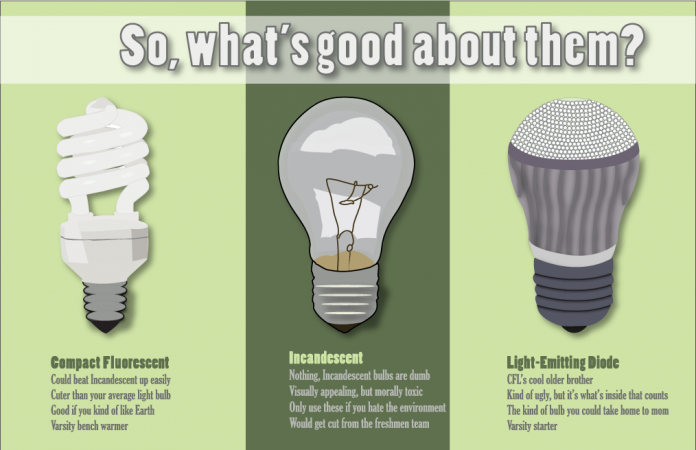LED lights bulbs are likely to be the replacement of traditional incandescent light bulbs. While CFLs are also a possible replacement they are a temporary option for those interested in energy efficient lights. At first LED bulbs had a smaller area of coverage and were more costly than their CFL counterparts. But those disadvantages are quickly disappearing.
LEDs are starting to solve the coverage issues by “clustering” which provides a substantial amount of light. Using diffuser lenses you can spread the light in a greater area which alleviates the problem as well. Prices for LEDs have fallen to the point where they can be cheaper than CFL or incandescent bulbs as well. Their price is likely going to fall even further in the future.
Despite this CFLs and incandescent bulbs remain fairly popular with consumers. In the following charts we will compare both the efficiency and cost effectiveness of these three technologies.
Cost Comparison between LEDs, CFLs and Incandescent light bulbs
| LED | CFL | Incandescent | |
| Light bulb projected lifespan | 50,000 hours | 10,000 hours | 1,200 hours |
| Watts per bulb (equiv. 60 watts) | 10 | 14 | 60 |
| Cost per bulb | $35.95 | $3.95 | $1.25 |
| KWh of electricity used over 50,000 hours | 500 | 700 | 3000 |
| Cost of electricity (@ 0.10per KWh) | $50 | $70 | $300 |
| Bulbs needed for 50k hours of use | 1 | 5 | 42 |
| Equivalent 50k hours bulb expense | $35.95 | $19.75 | $52.50 |
| Total cost for 50k hours | $85.75 | $89.75 | $352.50 |
Energy Savings over 50,000 hours, per 1 bulb:
| Total cost for 1 bulb | $85.75 | $89.75 | $352.50 |
| Savings to household by switching from incandescents | $266.75 | $262.75 | 0 |
Notes:
* The cost of electricity is an approximation. The actual cost varies greatly and can range from 28 cents per KWH in Hawaii to 6 cents in Idaho.
* Cost per bulb is also an approximation and vill vary. The average cost is 35.95$ for a 60 Watt LED bulb (the figure used in the comparison).
* Bulb lifespan is an estimation since an accurate test would take around 6 years of continuous lighting. Some manufacturers say that their LED bulbs can last up to a quarter of a century, but there’s no evidence to suggest this is true.
* This chart does not take bulbs breaking and replacement costs into account. Incandescent and CFL bulbs break more often than LED bulbs which would likely increase their cost of use.
* LEDs typically come with at least a 2 year warranty. If the bulb is defective it’s very probable that it will break during this time.
Comparing the features of Incandescent, CFL and LED bulbs
| LEDs | CFLs | Incandescents | |
| Frequent On/Off Cycling | no effect | shortens lifespan | some effect |
| Turns on instantly | yes | slight delay | yes |
| Durability | durable | fragile | fragile |
| Heat Emitted | low (3 btu’s/hr) | medium (30 btu’s/hr) | high (85 btu’s/hr) |
| Sensitivity to temperature | no | yes | some |
| Sensitivity to humidity | no | yes | some |
| Hazardous Materials | none | 5 mg mercury/bulb | none |
| Replacement frequency (over 50k hours) | 1 | 5 | 40+ |
How to choose LED right bulb?

There are many bulbs and models in today’s market. Consider the following factors when choosing an LED light bulb.
* Estimate desired wattage: The package will contain information about the wattage of the bulb which will determine how bright it is. A 3W LED bulb will have the same illumination level as a 45W incandescent light bulb.
* Warm / Cool light: Cool white light is considered ideal for task lighting while warm light is typically used for small area lighting and accents in design.
* Standard / Pin base: LED bulbs can have a number of pin sockets, or the standard screw (Edison) type bases depending on whether you want recessed or track lighting.
* Standard / Dimmable bulbs: Plenty of bulbs are now available in a dimmable option, such as the FEIT bulbs.
The following are some popular style of LEDs for average households:
Diffused bulbs
This type of light utilizes a dimpled lens on clusters of LEDs which spreads it over a larger area. These are available in the standard Edison bases, which allows them to be used for many purposes such as area lighting for rooms, porches and decks, reading lamps, accent lamps and other low light applications that have to remain on for a prolonged period of time.
Dimmable Globe LED bulbs
These are usually used in bathroom vanities but can be useful anywhere that a globe bulb would be needed. They can output light that is the same brightness as a 40W incandescent bulb but only require 10W of electricity. They are dimmable and can go from as low as 10% power to 100%. They also have a 200 degree beam angle which helps them cast light in a wide area.
Notes:
*Dimmable LEDs are usually more expensive (around 40%) than non-dimmable LEDs.
Track Lighting
These LEDs are also available with the standard Edison base as well as a pin base. This makes them very well fitted for track lighting. LEDs will not generate a lot of heat, and thus will not contribute to heat buildup no matter how long you leave them on. Since they are up to 90% more efficient than incandescent bulbs and last far longer, they will not need to be replaced as quickly.
Flood Reflector LEDs for Recessed Cans and Track lights, screw-in base
LEDs are capable of being used for standard recessed lighting pots and housings. They can be 7.5 watts at the minimum and 17 watts at the maximum and have beam widths ranging from PAR20 to PAR38. Some of these bulbs are dimmable. Since they are up to 90% more efficient than incandescent bulbs and last far longer, they will not need to be replaced as quickly.
Flame Tip, Candelabra Base LEDs
These were originally made in order to replace incandescent candelabra bulbs. These LEDs deliver the illumination levels of 25-35 watt incandescent bulbs while only drawing around 3 watts of power. The light also doesn’t disperse downwards as much due to a heat sink in the base.
LED Tube Lights
These LED lights were made to replace fluorescent tube bulbs and are available in 8 and 16 watts. This is a replacement for the 25 and 40 watt fluorescent tubes. They need to be changed far less often, which is great because they are used often in commercial sites with high ceilings.
LED Terminology
LED
LED stands for light-emitting diode. A diode is an electronic component that allows current to flow in one direction.
Lumens
the SI unit of luminous flux, equal to the amount of light emitted per second in a unit solid angle of one steradian from a uniform source of one candela. Or in other words it is a measurement of the flow of lights and provides an estimate of the amount of light the bulb will produce.
Coloring Rendering Index (CRI)
How well the bulb will render colors and the quality of light. The FEIT dimmable 13.5 watt warmwhite bulb for example, has a CRI of 75 for Cool white and 80 for Warm White, which is one of the best in the market.
Wattage

Wattage is a measure of electrical power expressed in watts. LEDs use very low wattage in comparison to incandescent, fluorescent and halogen lights. For example, for Aurora™ MR-16 bulbs, 1 watt is equal to 9 watts of an incandescent bulb, and will last 26 times longer. The higher the wattage, the higher the lumens.
Equivalent wattages and light output of Incandescent, CFL and LED bulbs:
| Light Output | LEDs | CFLs | Incandescents |
| Lumens | Watts | Watts | Watts |
| 450 | 4 – 5 | 8 – 12 | 40 |
| 750 – 900 | 6 – 8 | 13 – 18 | 60 |
| 1100 – 1300 | 9 – 13 | 18 – 22 | 75 – 100 |
| 1600 – 1800 | 16 – 20 | 23 – 30 | 100 |
| 2600 – 2800 | 25 – 28 | 30 – 55 | 150 |

